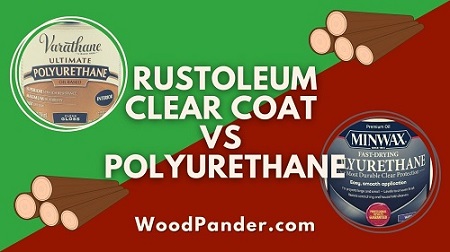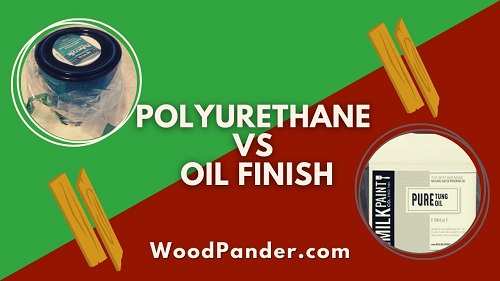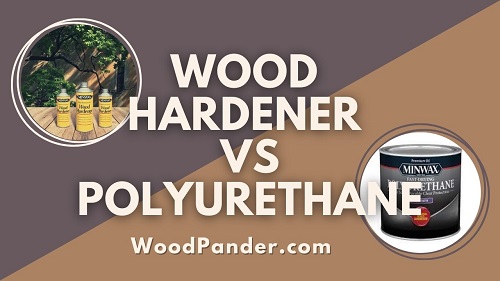In the world of woodworking, the finish is what brings out the beauty in a piece and offers it long-lasting protection.
The two prevalent finishes used are Arm R Seal VS Polyurethane. Although they serve the same purpose, their properties and applications differ substantially, making it important to understand these differences in order to make the best choice.
This essay delves into a detailed discussion about Arm R Seal vs Polyurethane, covering everything from their chemical compositions to their practical applications, and providing a comparative analysis of their performance and usability.
Arm R Seal vs Polyurethane–A Comparison Table
| Aspect | Arm-R-Seal | Polyurethane |
|---|---|---|
| Application | Easy to apply with a cloth | Can be brushed, sprayed, or rolled |
| Drying Time | Longer drying time (4-6 hours between coats) | Faster drying time (2-4 hours between coats) |
| Number of Coats | Fewer coats required (usually 2-3) | More coats may be needed (often 3-4) |
| Appearance | Enhances wood grain, produces a warm, natural look | Can have a slightly plastic-like appearance |
| Durability | Excellent durability, resistant to water and wear | Good durability but may show wear over time |
| Odor | Minimal odor | Strong chemical odor |
| Cleanup | Requires mineral spirits for cleanup | Requires mineral spirits or water for cleanup, depending on type |
| Use Cases | Ideal for fine woodworking and furniture | Suitable for a wide range of indoor wood projects |
| Price | Typically more expensive | Generally more budget-friendly |
| Maintenance | Easy to repair and maintain | May require more frequent maintenance |
Arm-R-Seal VS polyurethane are both popular wood finishes. Arm-R-Seal is an oil-based finish known for its deep, rich appearance and easy application. It offers excellent durability and is ideal for fine woodworking projects. Polyurethane, on the other hand, can be oil-based or water-based and provides a tough, protective finish. It’s versatile and suitable for various applications, including floors and outdoor projects. The choice between them depends on the specific project and desired finish characteristics.
Understanding Arm R Seal VS Polyurethane
Delving Deeper into Arm R Seal and Polyurethane
For individuals delving into the world of wood finishes, two prominent options often arise: Arm R Seal and Polyurethane.
These two protective wood finishers play a key role in not only safeguarding wood surfaces but also amplifying their visual aesthetic.
Each has its unique set of characteristics, application methods, and chemical compositions.
Exploring Arm R Seal
Serving as a renowned brand under the canopy of General Finishes, Arm R Seal shines due to its durability and straightforward application.
It represents a power-packed combination of oils and urethanes, delivering impressively resilient finishes. Its solvent-rich nature and superior-grade resins empower it to provide better resistance to water and alcohol than customary oil finishes.
Projects requiring durability and pronounced wood grain, such as countertops, cabinets, and flooring, frequently rely on Arm R Seal.
Understanding Polyurethane
Polyurethane is a synthetic varnish used extensively in preserving and enhancing wooden surfaces.
It forms a sturdily clear shield protecting woods from moisture and scratches. The flexible nature of Polyurethane promises resilience even in extreme weather conditions.
However, despite the stringent shield it provides, polyurethane tends to remain on the surface rather than penetrating deep into the wood, often losing some of the wood’s natural depth in the aesthetics.
Aesthetic Variance
Deciding between Arm R Seal and Polyurethane often comes down to aesthetic preferences. Arm R Seal generally presents a more organic finish, subtly highlighting the wood’s natural charm.
On the other hand, Polyurethane is known for a brighter, glossier exterior that’s more akin to a plastic shine; some find this appealing for its polished and protective finish.
Considerations in Application and Drying
Application methods and drying times further help differentiate Arm R Seal vs Polyurethane. Arm R Seal often requires fewer coats applied via a wipe or brush, with a faster drying time. In contrast, Polyurethane tends to require more layers and a longer drying period, typically applied with a brush.
Overall, both Arm R Seal and Polyurethane serve as reliable wood finishers with unique features. Your decision between the two largely depends on the requirements of the project, aesthetic preferences, and confidence with each product’s application procedure.

Applying Arm R Seal and Polyurethane
Procedure for Applying Arm R Seal
Extending the beauty and longevity of your fine woodwork is simple with Arm R Seal.
The application process requires a high-quality natural bristle or foam brush, lint-free rags, a well-ventilated work area, and of course, the Arm R Seal product.
It is imperative that your wood surface is thoroughly cleaned and dried prior to application. All old coatings, be it paint or previous finish must be completely removed. Ideally, you should apply Arm R Seal in a temperature-controlled environment, between 50°F (10°C) and 90°F (32°C).
Once prepared, stir the Arm R Seal thoroughly to blend any settled contents. Immerse your brush or rag into the can lightly, then evenly coat the wood, moving along the grain. Care must be taken to avoid overloading the brush or rag to prevent drips or thick patches.
Allow the initial layer to cure for 12-24 hours, then use a 220-grit sandpaper to smoothly sand the surface. Dust off the residue and reapply a thin layer.
Usually, the application process demands three coatings for optimal durability. If smudges, drips or bubbles form, allow the finish to completely set, then smoothen, clean and apply another layer.
Applying Polyurethane
Polyurethane is a durable varnish that offers superior protection and is available in both oil-based and water-based forms. To apply, you need a bristle or foam brush, a clean workspace, and the polyurethane product.
First, ensure the surface is clean and dry. Ideal temperature conditions for application range between 50°F (10°C) and 90°F (32°C). Stir the can gently to mix up any settled material and avoid creating bubbles.
In similar fashion to the Arm R Seal, apply a thin coat with the brush, flowing the material along the grain of the wood. Don’t load the brush too much to keep runs and drips at a minimum.
Let the first coat dry for a minimum of 2 hours for water-based polyurethane and 24 hours for oil-based polyurethane. Then lightly sand the surface with fine-grade (220-320) grit sandpaper, and remove the sanding dust.
Apply a second coat and let it dry. Three coats are typical, but extra coats may be applied for even higher durability and richer finish. If you spot a drip or bubble, you can sand it out after the finish has dried, and then reapply more polyurethane.
Understanding Arm R Seal and Polyurethane
One must look closer to understand the differences and similarities between Arm R Seal and Polyurethane, two durable finishes that add charm to wood surfaces. However, the unique characteristics of both make them suitable for different applications.
Arm R Seal is distinctively an oil-based finish, whereas Polyurethane can either be oil or water-based. Over time, oil-based finishes like Arm R Seal take on a warm amber hue, enhancing the natural glow of the wood.
Contrarily, water-based polyurethane concentrates on preserving the original color of the wood, adding virtually no coloration and maintaining its clarity even years down the line. This makes it perfect for lighter woods or any surfaces where an authentic wood color is desired.
When it comes to durability, Polyurethane has a slight edge. It is known to be more resilient against heat, chemicals, and general wear and tear, making it the ultimate choice for items such as kitchen tables or floors that withstand continuous use. Arm R Seal, although durable, may not endure heavy use as efficiently as Polyurethane.
For both finishes, the application process remains largely similar, but drying times do vary. Polyurethane, most notably when oil-based, generally requires a longer drying period.

Performance Comparison
Durability Comparison: Arm-R-Seal vs Polyurethane
Digging a bit deeper into their durability, both Arm-R-Seal and Polyurethane prove to be strong contenders.
Arm-R-Seal, an esteemed polyurethane product from General Finishes, stands out for its ability to form a robust, scratch-resistant seal on a diverse range of wood surfaces. In addition to this, it also offers superior protection against water damage and unruly weather conditions.
Alternatively, whether oil or water-based, Polyurethane provides superb resistance to scratches, heat, and chemicals. What distinguishes them further is the coloration effect – oil-based polyurethane might amber eventually, imbuing the wood surface with a warm radiance, while water-based formats ensure the wood’s natural hue stays untouched.
Ease of Application
In terms of ease of application, both Arm-R-Seal and Polyurethane can be easily applied with brush, roller, or cloth. Arm-R-Seal has a slightly thicker consistency, but it smoothens out as you brush it onto the surface, reducing the likelihood of drips or runs.
It requires fewer coats compared to many polyurethanesh. Polyurethane, however, requires careful application and sanding between the layers to avoid visible brush strokes or bubbles.
Maintenance Requirements
Routine maintenance for both finishes is similar. Areas finished with Arm-R-Seal or Polyurethane should be cleaned with a soft, damp cloth to prevent dust accumulation.
Application of furniture wax or polish isn’t necessary or recommended as it may hinder the finish’s protective capabilities.
Avoid placing hot items directly on the finish and use coasters or placemats to help prolong the lifespan of the finish.
Overall Look
The final appearance differs between Arm-R-Seal and Polyurethane. Arm-R-Seal leaves a natural-looking finish, enhancing the wood’s beauty with a slight golden tint.
It’s recommended by many professional woodworkers for the depth and richness it imparts to the wood grain. Conversely, Polyurethane, especially water-based ones, provides a clear finish, maintaining the wood’s original color while adding a reflective sheen.
It’s loved for the lustrous and glass-like finish it generates on the surface.
Cost Factor
Finally, talking about cost-effectiveness, both finishes have pretty similar price ranges, with minor fluctuations based on brand and quantity.
However, considering you may require fewer coats with Arm-R-Seal, it could potentially be more cost-effective for larger projects. That said, the decision should not be solely money-driven, as the final look, protection level, and project’s nature also hold significant importance.
Both Arm-R-Seal and Polyurethane serve as excellent choices for providing a durable finish to wood projects. Your decision between the two may be influenced by factors such as the desired aesthetic, required durability, and the specific nature of the project at hand.

Choosing Between Arm R Seal and Polyurethane
Distinguishing Between Arm R Seal and Polyurethane
Let’s delve a little deeper into both of these options. Arm R Seal is an oil-based finish lauded for its ability to render a smooth, durable coat.
This finish is highly resilient and offers protection against water, solvents, and various household chemicals, making it ideal for hardwood floors, kitchen tables, and similar surfaces that require a robust protective barrier.
Polyurethane, conversely, is a synthetic finish that also delivers a hard-wearing shield for wooden surfaces. It comes in two varieties – oil-based and water-based. Oil-based polyurethane tends to lend a richer finish color, while water-based polyurethane is known for its ease of cleanup and lower toxicity.
Critical Factors: Purpose of Project and Material
When choosing between Arm R Seal and Polyurethane, understanding the purpose of the project and the materials used are crucial. If working with hardwood that requires a robust finish, like oak, for instance, Arm R Seal is an excellent choice, particularly if the item will be heavily used or exposed to potential damage.
Its impressive resistance to household chemicals makes it ideal for kitchen tables and other high-use areas.
For projects likely to be exposed to direct sunlight, Polyurethane (specifically, a version that includes UV blockers) might be a better choice.
Polyurethane is also the preferred choice for lighter woods like maple or birch, as it does not affect the wood’s natural color as much as Arm R Seal.
Environmental Factors & Ease of Application
Arm R Seal requires a minimum temperature of 50 degrees Fahrenheit to apply and adequate ventilation due to its strong fumes. It needs multiple coats for optimal results, and each layer should be left to dry for several hours in between.
Polyurethane, however, can be applied at a wider temperature range (55-90 degrees Fahrenheit for water-based and 65-90 degrees Fahrenheit for oil-based) and comes with fewer fumes, making it easier to work within confined spaces.
The application of Polyurethane also could be more straightforward for beginners because it is less prone to drips or running — a common issue when applying Arm R Seal.
Personal Preferences: The Look and Final Finish
Personal preference plays a significant role when choosing between Arm R Seal and Polyurethane.
Arm R Seal generally produces a semi-gloss or satin finish that enhances the natural grain of the wood, making it a good choice for those who aim to highlight the character of the wood.
On the contrary, Polyurethane finishes tend to lean towards a glossy finish which gives the wood a bit of a plastic look because it builds up on top of the wood rather than soaking in.
When selecting a suitable finish for your woodwork projects, the choice between Arm R Seal and Polyurethane becomes an essential aspect to consider.
This decision depends heavily on different factors such as the nature of your project, the type of wood you’re working with, the expected environmental conditions, as well as your personal aesthetic preferences.
By understanding the unique properties, advantages, and possible drawbacks of each finish, you can make a well-informed decision that’s most conducive to your specific needs and scenarios.

Maintenance and Care
Delves Deeper Into Arm R Seal and Polyurethane
Among various finishes available for woodworking, Arm R Seal vs Polyurethane stand out due to their commonly used nature.
Arm R Seal primarily serves as a topcoat, imparting a durable protective layer that not only brings out the innate beauty of the lumber but also imparts it a warm and attractive sheen. Furthermore, it is highly water-resistant, qualifying it as an ideal choice for wood surfaces located both indoors and outdoors.
Conversely, Polyurethane offers impeccable defense to wood surfaces too. However, due to its exceptional durability and resilience, it often becomes a preferred choice for surfaces prone to high traffic or pieces of furniture.
This finish can also be tailored to your desire – it can either highlight the wood’s natural hue or offer a transparent, non-yellowing finish, depending on the particular product.
Cleaning and Maintenance for Arm R Seal and Polyurethane
As part of the maintenance process for both Arm R Seal and Polyurethane, it’s important to clean the surfaces regularly.
For Arm R Seal, it’s best to avoid strong, harsh cleaning agents as this could potentially strip away the finish. Instead, use a soft, damp cloth to gently wipe away dust and spills. If necessary, a mild non-alkaline soap can be used, so long as the surface is quickly dried afterwards.
Polyurethane surfaces, on the other hand, can handle stronger cleaning agents, thanks to its robust finish. However, to prolong its lifespan and keep the surface looking fresh and clean, it’s still advisable to use mild soap and water for regular cleaning, and thoroughly dry the surface after washing to avoid water spots or rings.
Longevity of Arm R Seal and Polyurethane
When it comes to the longevity of Arm R Seal and Polyurethane, a lot depends on how well they are maintained and the conditions they are exposed to.
For example, if the wood furniture finished with Arm R Seal is frequently exposed to sunlight, it might start to lose its sheen faster.
Polyurethane, on the other hand, is more resistant to sunlight, heat, and moisture, which can greatly increase its longevity, making it more suitable for exterior and high-trafficked applications.
However, even with its stellar durability, it too will eventually wear down over time, necessitating a new layer every few years.
Managing Potential Damage or Wear
Unfortunately, no wood finish is immune to damage, whether from spills, scratches, or general wear and tear. However, with proper care and attention, it’s possible to manage these issues.
For Arm R Seal, if damage occurs, lightly sand the damaged area with fine-grit sandpaper until smooth. Wipe clean, and re-apply Arm R Seal to the sanded area to restore the finish.
For Polyurethane finished surfaces, similar steps can be taken to manage potential damage. Sand the affected area, ensure that it’s clean and dry, and then apply a new coat of polyurethane with a quality brush.
Remember, prevention is often the best remedy. Using coasters, placemats, and other protective items can help shield your surfaces from daily wear and potential damage. And whenever possible, try to keep your wood furniture away from extreme temperatures or direct sunlight.

After considering the various features, applications and performance of both Arm R Seal vs Polyurethane, it becomes clear that there is not one universally superior choice.
The ideal option largely depends on the nature of your specific project, your personal preferences, environmental factors and the desired aesthetic result. Armed with this understanding of the two types of finishes, you can make an informed decision about which one to use for your next woodworking project.
Furthermore, to ensure longevity, protect your investment and keep your project looking its best, proper maintenance and care certainly cannot be overlooked.
Related Questions
Can I use Arm-R-Seal over polyurethane?
Yes, you can apply Arm-R-Seal over a previously applied polyurethane finish, but proper surface preparation and compatibility testing are essential for a successful outcome.
Is Arm-R-Seal heat resistant?
Arm-R-Seal is reasonably heat resistant and can withstand moderate heat exposure. However, prolonged or extreme heat can still damage the finish, so it's important to use protective measures like trivets or coasters for hot objects.








